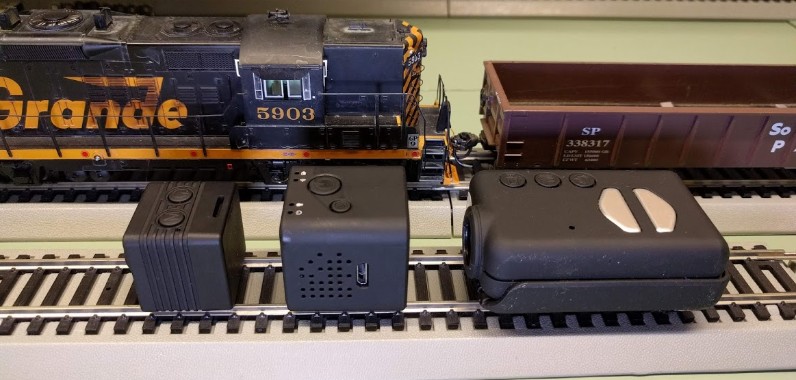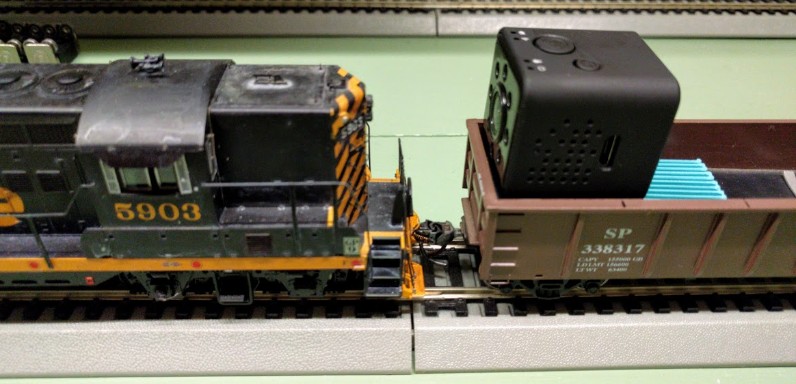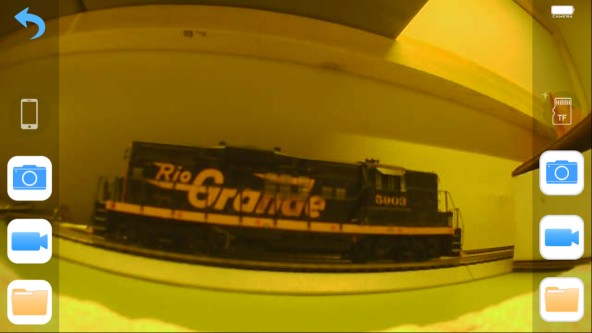Model Train-related Notes Blog -- these are personal notes and musings on the subject of model train control, automation, electronics, or whatever I find interesting. I also have more posts in a blog dedicated to the maintenance of the Randall Museum Model Railroad.
2018-12-09 - SQ23 Mini Camera for Cab Rides
Category Video
After trying the SQ12 camera, I moved on to its newer sibling, the SQ23. The goal is to use it to record cab rides. As this one has wifi, a secondary goal is to see if it’s suitable as a “live camera” e.g. to broadcast a ride view to a screen.
Cab ride filmed using SQ23 Camera
This is the SQ23 Camera I got from Amazon (can be found cheaper elsewhere, e.g. on Aliexpress), compared to my Mobius Action Cam and the SQ12 camera:
From left to right: SQ12, SQ23, Mobius compared to an HO-size engine + gondola
From left to right: SQ12, SQ23, Mobius, top view.
Although the SQ23 is larger, at 30x28 mm it still fits neatly inside the HO-size gondola and fits within the HO gauge clearance (although you may want to double check the height if using the “old era” NRMA gauge for tunnels):
I’m going to do my review in reverse by starting with what was terrible, and then what worked well.
The negative points:
- Similar to the SQ12, this is not a 30 fps camera, it’s a 25 fps with a 2:3 pulldown!
- Similar to the SQ12, this is not a 1080p camera. It’s yet another 720p upscaled to 1080p.
- The image is fairly soft and lacking sharpness. Either the lens isn’t great, or it is not in focus, and there’s no way to adjust it. In other words the video quality is terrible.
- Extremely poor automatic exposition & white balance handling from the camera. The video is mostly neutral most of the time and will wildly shift to over saturated under some type of lighting. There’s unfortunately no control over this.
- White balance was often off, with a clear green tint under fluorescent lighting and an extremely pronounced yellow tint under LED lighting, then it would suddenly fix itself to something neutral. Filming the same scene twice would not given consistent white-balance results. This is a headache from a video editing perspective.
- The video shows extreme “beat effect”, as typically seen with 60 Hz light flickering not matching the recording frame rate of 25 Hz.
- When initiating a video recording via wifi (see below), there’s a “beat effect” on the recording sound too.
Disclaimer: To be clear, there are some good video clips made with SQ23 cameras out there. These work great for outdoor scenes (e.g. drones) or for any lighting that is not susceptible to the 25/60 Hz mismatch -- e.g. anything in Europe/Asia at 50 Hz, or anything recorded using non-fluorescent non-LED lighting. I am naturally biased here in that I am focusing on the specific needs I have, and I am not trying to make a super generic-for-all review.
I’ve added a cab ride video of the layout at the beginning of the article. It shows the fairly wild and inconsistent white-balance issue, and the flickering (and that’s after improving it somewhat in post-editing). One issue I found is that although the camera did the layout tour twice, it did not get the lighting the same way every time. This makes it harder to mix & match video clips in edit/post and is fairly obvious in the video.
One positive aspect of the camera is its small size. As shown in the cab ride video, I found it quite convenient to place it track side and get a variety of more creative point of views. The small 1-inch size allows for easy placement next to an HO track, at about “human eye” track level which is often not possible with larger cameras or cell phones. The fact I can preview the shot before recording using wifi (see below) really helps in setting up the view angle.
Let’s move on with the review.
Models SQ12 vs SQ13 vs SQ23:
There are various “SQ” cameras and the model names can be somewhat confusing.
There’s an SQ13 model out there that does not seem to differ from the SQ23. As far as I can tell from specs online, the SQ13 and the SQ23 seem to be the same camera.
The SQ12 is a different camera, with no wifi. You can view my review of the SQ12 here.
Let’s compare these models based on specs (all allegedly, from marketing brochures & forums):
- Common: CMOS sensor, max 32 GB sdcard.
- Mobius: 2013, Novatek NT96650 processor, Aptina AR0330 CMOS sensor, 520 mAh battery (more details).
- RunCam 2: 2015, 850 mAh battery.
- SQ12: 2017, GeneralPlus 1248, 200 mAh battery.
- SQ13: 2018, GeneralPlus GPCV4247, 300 mAh LiPo.
Thanks to spam comments on my youtube video (seriously, if you’re going to leave twice the same exact comment from different profiles, don’t be surprised to be flagged as spam!), I got at least the indirect answer to “SQ13 vs SQ23”, and namely the answer is there isn’t. Both spam comments linked to this online “user” manual which clearly indicates the difference is just in accessories, not in the camera itself.
Specs for the SQ23 generated files in “1080p” (but really 720p upscaled):
Input #0, avi, from 'MOVI0025.avi': Metadata: ISRC : Generplus artist : Generplus copyright : Generplus date : 2010-06-29 Duration: 00:10:00.07, start: 0.000000, bitrate: 24533 kb/s Stream #0:0: Video: mjpeg (MJPG / 0x47504A4D), yuvj420p(pc, bt470bg/unknown/unknown), 1920x1080, 24343 kb/s, 30 fps, 30 tbr, 30 tbn, 30 tbc Stream #0:1: Audio: pcm_s16le ([1][0][0][0] / 0x0001), 32000 Hz, 1 channels, s16, 512 kb/s |
Wifi Usage:
Despite the size similarity, this camera and its sibling the SQ13 differ from the previous models in that it has wifi. This is something I desire, not necessarily for streaming, but for ease of setting up. My goal with cab rides videos is to enable wifi while I set up the camera on the train or scenery to adjust the view, then I can turn wifi off and record without wifi during the cab ride to save on battery.
That goal is easily accomplished with this specific camera. When wifi mode is enabled, the wifi generates a local wifi network, which has a password by default. The documentation even encourages users to change it first hand, which is a nice touch. There’s a QR code in the skinny documentation that leads to an Android app, with terrible reviews. Sure it’s not the greatest app ever, but once one understands how to use it, it’s quite usable. Many of the negative reviews complain that some parts of the app are poorly translated and there are still Chinese strings on screen -- OMG, can you believe it, the whole world doesn’t speak solely English! That didn’t bother me as it always showed up in parts of the app that were logical and easy to understand due to other iconography.
Since the wifi process was similar to the RunCam2, I had no problem understanding what to do, but I can see how others might struggle with it as it can be a tad subtle; let me explain its usage:
- Turn the SQ23 camera on by pressing the power button 3 seconds. Red led turns on.
- Turn the wifi mode on by pressing the M button 3 seconds. Green led turns on.
- Wait a few seconds and connect the phone to the “SQ13_something” wifi network that appears (yes I totally see the irony in the model number). Note that range should probably be in the 2-6 feet to work.
- The first time, wait for Android to realize this network has no internet access. Android will pop up a notification asking whether to stay connected → check the remember box and say yes at this point, otherwise Android will automatically disconnect from the network, making the whole process a big pain.
- Once the phone is connected to the camera’s wifi, the green led blinks. The app will not work if the green led is steady. Pay attention to that, as it did trip me a few times.
- Install and launch the app, or if already launched, click the big “play” text. App tries to connect. Sometimes this takes a few tries but overall it was fairly reliable when I tried.
- At that point you can use the settings button in the app, e.g. to turn the timestamp off.
- Once the connection is established, the app screen changes to a page that has the video in the middle and 2 rows of similar vertical icons: the left ones are to record on the phone, and the right ones are the record on the camera sdcard. There’s an icon to take a picture, one to record a video, and a media manager access to see recorded files (play, download).
So yeah that’s a lot of steps, and it’s easy to get confused, or miss one, or get them wrong the first time.
Anecdote: The Android app’s name is “Sports DV” and the internal package name is “com.libo.GPCamDemoa”. GP here obviously stands for General Plus, which makes the GPCV4247 chipset. “Cam Demo A” is kind of cute in the package name. Cute as in “not very profesional”.
Here’s a screenshot of the app once connected, same engine as seen in the pictures above:
Obvious issues here:
- Pronounced yellow tint under my 3000K LED lighting (which nowhere looks like that in real life, as can be seen with the pictures above of the same engine & location, taken with the cell phone). This is a typical issue due to white-balance being confused by LED lighting.
- Lack of clarity, camera was about 4 inch away from the engine. This should have been crystal clear.
- Barrel distortion to be expected from the wide angle.
The white-balance issue as well as the barrel distortion can be fixed in a video editing software.
What you do not see is the “beat” effect even on the LED lighting. This is however visible in the first few seconds of the youtube clip above.
Sound Volume:
When recording sound, the volume is consistently 6~9 dB below was I got from the SQ12 -- I actually had to tone down the SQ12 volume by 6 dB when editing the cab ride video. That wasn’t much a problem here and the level was acceptable. The video posted above has the volume level unchanged.
Sound Issue when Recording from the App:
The right middle button on the app initiates a recording to the sdcard. One would think it would give the same results as when recording on the camera without using wifi. However that’s not the case. Although the video is of the same quality, the audio is different and contains a pronounced “flutter / beat effect”. Here is a video sample with the raw sound & video as recorded:
So far I’ve established that the camera can be used for cab rides, with the caveat that the beat effect on the video and the sound and an overall vastly unimpressive video quality make it basically unusable for that purpose.
Live View:
Is it a good camera to provide an onboard live view on the layout? Well “somewhat… maybe… not really”:
- Using the wifi mode quickly drains the battery, more than just straight recording. A quick estimate is that we’d be lucky to get half an hour out of it and I think I’m being extremely generous here. Probably a lot less actually.
- Since the device is the one generating the wifi hotspot, the range becomes an issue very quickly. A quick test worked fine with a 3-4 yard range in direct line of sight, with some noticeably choppiness in the video stream when I was getting farther. However since all the tunnels on this layout are wire mesh, I don’t think it will work very well for a full layout tour due to the combination of distance and obstacles to the signal.
The battery aspect could be solved with e.g. extra batteries and maybe trying to recharge them from the track’s power supply. The signal obstacle is not really easy to solve though (it would be better if the camera could connect to an existing wifi network with potentially repeaters).
Conclusion:
All in all it’s not a bad little camera. It can easily be found for ~$20, which is quite a lot less than a Mobius or RunCam 2 (around $70-90). However on this camera, the video recorded was really not suitable for recording cab rides and is a step down. All these cameras struggle with the kind of uneven lighting used on this layout yet this one managed to fare even worse and it’s a far cry from their advertised specs in e.g. outdoor environments. And as usual I don’t quite understand why vendors feel they need to plain lie on the specs. Why even pretend a camera is 1080p/30fps when it really is 720p/25fps? IMHO it fully hurts their credibility. Please be honest.
Like the RunCam 2, it’s a bit of a death by thousand cuts -- every feature is nice yet every feature also has just enough of an issue to ruin it. It can be used to record cab rides, but not good ones. It can record from the phone app, but that gives bad sound. It can be used to do live view, but not very long or with lots of drop outs. It can do 1080p, but it’s fake and it lacks sharpness. Most if not all of these issues can be fixed after the fact in post video editing, but at that point it’s worth considering whether it’s economical to do that.



